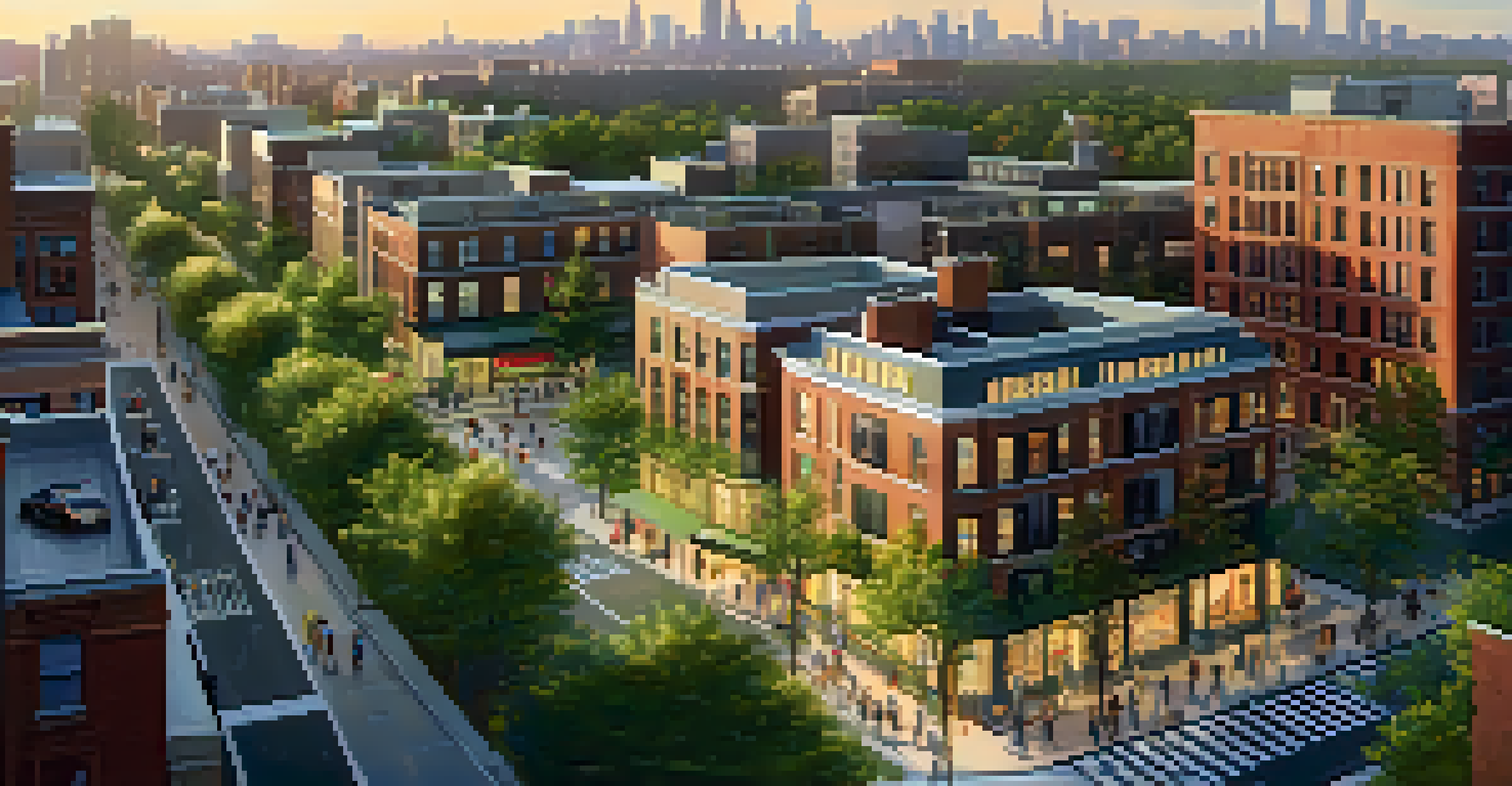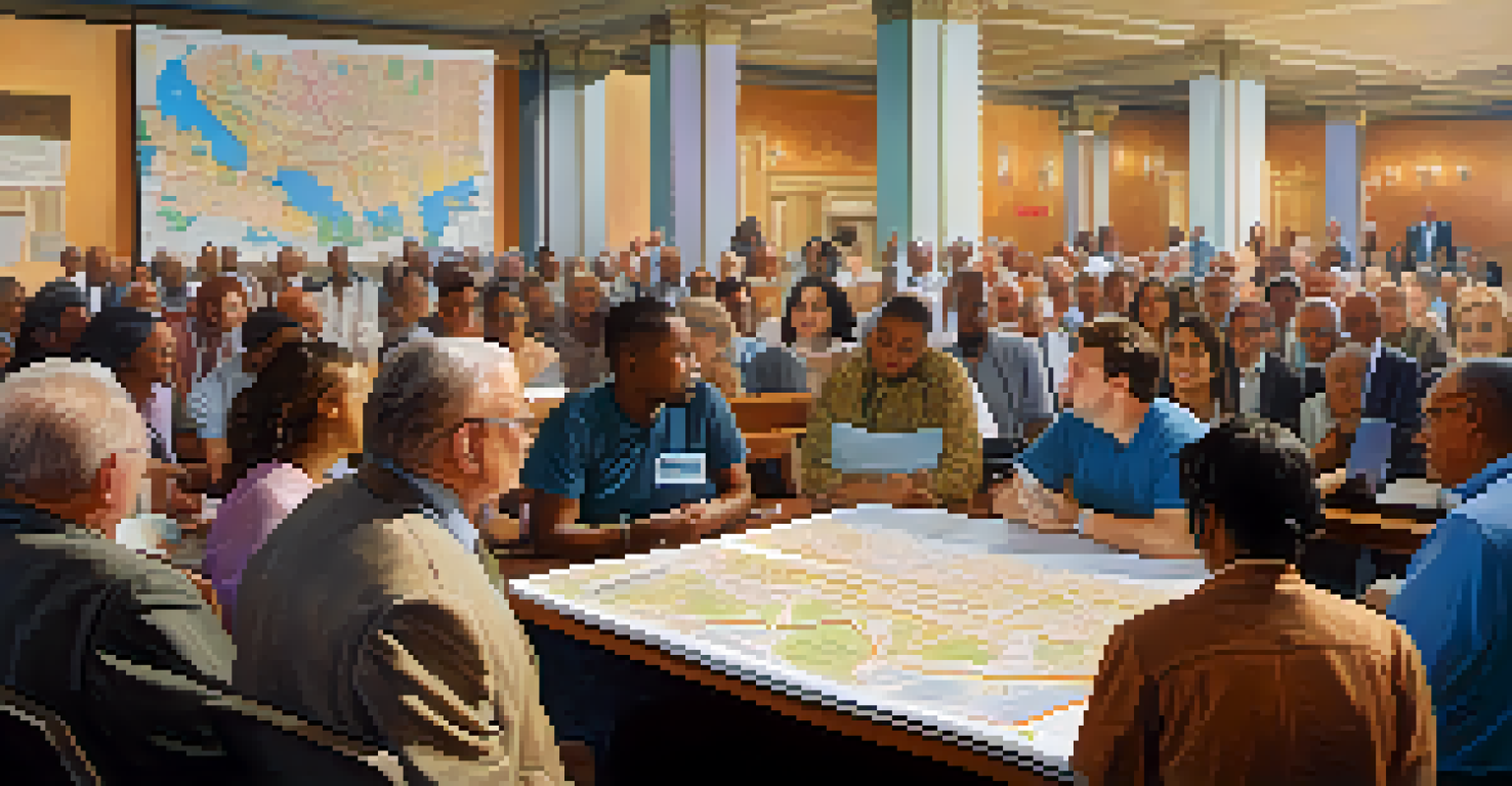The Role of NYC Planning Commission in Development

Overview of the NYC Planning Commission's Mission and Goals
The NYC Planning Commission plays a crucial role in shaping the city’s future. Established to guide urban development, its mission revolves around creating a livable, sustainable, and equitable environment for all New Yorkers. By focusing on long-term strategies, the Commission ensures that growth aligns with the city’s needs and values.
The best way to predict your future is to create it.
One of its primary goals is to balance development with community needs, which means listening to residents and understanding their concerns. This approach fosters a collaborative atmosphere where community input is valued, ultimately shaping policies that reflect the diverse voices of the city. Thus, the Commission acts as a bridge between city planners and the public.
In essence, the Commission's mission embodies a vision of New York City that embraces progress while preserving its unique character. Whether it's enhancing public spaces or ensuring affordable housing, the Commission’s goals reflect a commitment to nurturing a vibrant urban landscape.
Key Functions of the NYC Planning Commission
The NYC Planning Commission performs several key functions that guide the development process. One of the most significant is land use planning, which involves reviewing proposals for new developments and changes in zoning laws. This process ensures that developments fit within the broader context of city planning and serve the public interest.

Another essential function is the preparation of the City’s comprehensive plans. These plans outline long-term strategies for land use, transportation, and housing. By establishing a clear framework for development, the Commission helps to ensure that growth is systematic and aligned with the city’s overall goals.
NYC Planning Commission's Mission
The Commission aims to create a livable, sustainable, and equitable environment through community engagement and long-term strategies.
Additionally, the Commission plays a role in environmental reviews, assessing the impact of proposed projects on the city’s ecosystem. This function is vital for maintaining New York City's unique environment and ensuring sustainable development practices that benefit both current and future residents.
Public Engagement and Community Input in Planning
Public engagement is a cornerstone of the NYC Planning Commission’s approach to development. The Commission actively seeks input from community members through public hearings, workshops, and online platforms. This commitment to transparency ensures that residents have a voice in decisions that affect their neighborhoods.
Planning is bringing the future into the present so that you can do something about it now.
By facilitating these discussions, the Commission allows for a rich exchange of ideas and concerns. For example, when a new development is proposed, residents can express their views on aspects like traffic, housing, and public space. This feedback not only informs the Commission’s decisions but also builds trust between the agency and the communities it serves.
Ultimately, this collaborative process emphasizes that planning is not just a top-down approach; it’s a partnership between the city and its residents. By incorporating community input, the Commission helps create developments that truly reflect the needs and aspirations of New Yorkers.
Zoning and Land Use Regulations Explained
Zoning is a critical aspect of urban planning that dictates how land can be used in the city. The NYC Planning Commission oversees zoning regulations, which determine what types of buildings can be constructed in specific areas. This framework helps ensure that developments are compatible with their surroundings and meet the city's goals.
For instance, zoning can encourage mixed-use developments that combine residential, commercial, and recreational spaces. This approach not only fosters vibrant neighborhoods but also promotes walkability and reduces the need for extensive commuting. By integrating different land uses, the Commission helps create cohesive, thriving communities.
Importance of Public Engagement
Active community involvement is crucial for shaping development projects, ensuring they reflect the needs and aspirations of New Yorkers.
Moreover, zoning regulations can also address pressing issues like affordable housing and environmental sustainability. By strategically designating areas for specific uses, the Commission can influence everything from housing availability to green space preservation, ensuring that New York City remains a livable and dynamic urban environment.
The Role of Environmental Review in Development
Environmental review is an essential process that assesses the potential impacts of proposed developments on the environment. The NYC Planning Commission conducts these reviews to ensure that projects align with sustainability goals and adhere to environmental regulations. This process helps identify potential issues before construction begins.
The review typically involves evaluating factors such as air quality, noise, traffic, and ecological impacts. By examining these aspects, the Commission can recommend modifications or mitigation measures to minimize negative effects. This proactive approach not only protects the environment but also enhances the quality of life for residents.
Ultimately, the environmental review process underscores the Commission's commitment to sustainable development. By incorporating environmental considerations into urban planning, the NYC Planning Commission ensures that growth is not just about buildings, but about preserving the city’s natural resources for future generations.
Collaboration with Other City Agencies and Stakeholders
Collaboration is vital for the success of the NYC Planning Commission’s initiatives. The Commission works closely with other city agencies, such as the Department of Transportation and the Housing Preservation and Development, to ensure that development projects are well-coordinated. This teamwork helps align various aspects of city planning and policy.
Additionally, the Commission engages with local stakeholders, including business owners, community organizations, and advocacy groups. By fostering these relationships, the Commission can gather diverse perspectives and expertise, ultimately leading to more informed and effective planning decisions. This collaborative spirit enhances the likelihood of successful project implementation.
Challenges in Urban Planning
The Commission faces challenges such as rapid population growth, climate change, and complex zoning laws that require innovative and collaborative solutions.
Through this multi-faceted approach, the NYC Planning Commission exemplifies the importance of partnership in urban development. By leveraging the strengths of different agencies and stakeholders, the Commission creates a more holistic planning process that benefits all New Yorkers.
Challenges Facing the NYC Planning Commission Today
Like any urban planning agency, the NYC Planning Commission faces a unique set of challenges. Rapid population growth and increasing demand for housing put pressure on the Commission to develop innovative solutions. Balancing the need for new developments with community concerns can often lead to tension and conflict.
Additionally, issues related to climate change pose significant challenges for urban planning. Rising sea levels, extreme weather events, and other environmental factors require the Commission to integrate resilience into its planning processes. This means creating spaces that can withstand these changes while still serving the needs of the community.

Finally, navigating the complexities of zoning laws and land use regulations can be daunting. The Commission must continually adapt to changing policies and societal needs, all while ensuring that growth remains sustainable. Tackling these challenges requires creativity, collaboration, and a steadfast commitment to improving the lives of New Yorkers.